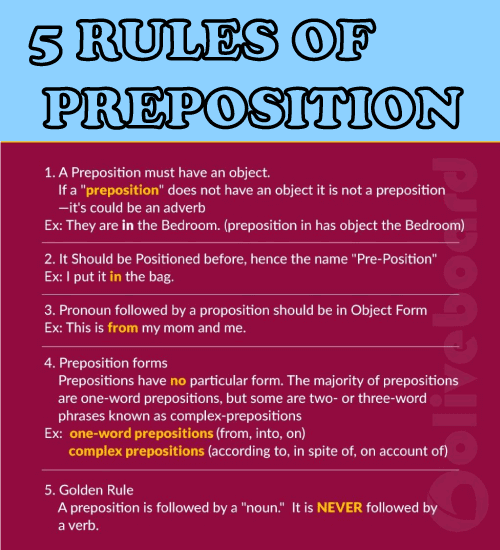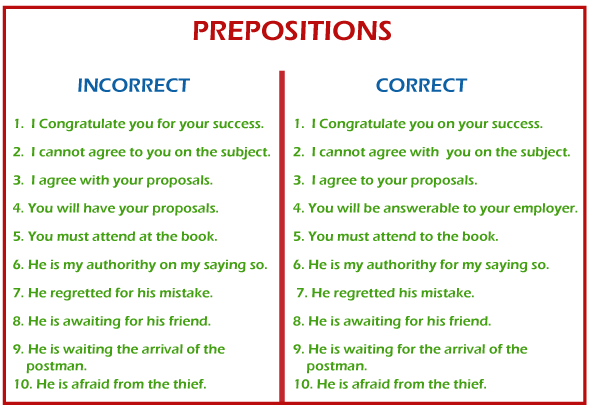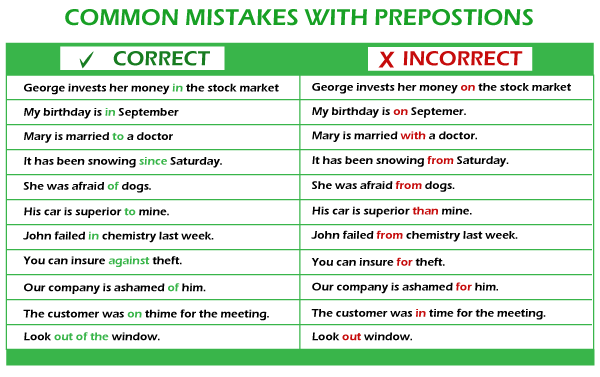Preposition RulesPrepositions are a small but vital word class. In our regular routine, we all use prepositions all the time. Understanding and effectively using prepositions help in substantially increasing the overall fluency of the language. What is a preposition?Prepositions and postpositions, collectively called adpositions, are a type of word which is used to establish a relationship among a noun, a pronoun, and other parts of a phrase. Some of the instances of prepositions include: in, under, towards, before, of, for, and so on. Prepositions are terms to describe relationships. They provide hints and connect the rest of the sentence. Given their importance, there are a few key guidelines to remember when using prepositions. These guidelines govern how these can be utilized, which prepositions can be utilized when, and where they should appear in a statements. Let's get started. Preposition RulesHere are straightforward and easy-to-follow preposition rules that will assist you in acing the grammatical component of many competitive exams. Also, the preposition rules below will assist you to understand and use prepositions productively. So, let's get started. 1. A preposition should have an object.Every preposition has an object. If a "preposition" lacks an object, it is often not a preposition; it is most likely an adverb. A preposition is most often accompanied by the object. An adverb is never accompanied by an object. So, it is essential for the prepositions to have an object. Consider the following sentences:
2. The term "pre-position" implies placing before.The term "preposition" refers to the fact that a preposition (typically) occurs before something (its object). This rule implies that, in general, a preposition appears before its object. However, it is not always the scenario. A preposition precedes a noun or a pronoun. Let's look at a few examples to better grasp this rule for prepositions: I put it in the bag. (in has an object bag and is positioned before the bag) Even if a preposition does not appear before its object, it is nonetheless strongly related to it: Who did you talk to? / I spoke to Jessica. 
3. A pronoun used after a preposition must be in the object form.A 'prepositional object' are usually the nouns or pronouns which come after the prepositions. If it is a pronoun, it must be in the objective form (me, her, them) instead of being in the subjective form (I, she, they):
4. Preposition FormsPrepositions, in essence, lack form and structure. The large number of prepositions are one word or term. However, there are those that are two to three words long and are referred to as complicated prepositions. Let us use examples to assist us to understand the subject more clearly: Prepositions with only one word, such as before, on, and into Complex prepositions such as according to, in spite of, because of, but for 5. The preposition 'to' should not be confused with the infinitive 'to'."To" is often used as a preposition (for instance, "to me," "to Delhi") and an infinitive participle (to sleep, to drink, to dance, etc.). Be cautious and avoid combining the two. For more clear writing, try considering the below mentioned examples: Using "to" as a Preposition
Using "to" as Infinitive Participle
6. Verb cannot be an object of the prepositionNext in the list of preposition rules is verb cannot be an object of the preposition. This is the Preposition's, Golden Rule. Words that appear to be verbs are often accompanied by prepositions "to," but a verb could never be the object of a preposition. Isn't it confusing? Read on to have a glance at an example:
"dance" and "dancing" are not verbs in the example above. To dance is part of the infinitive in the first instance, and it arises whenever the verbs are utilized as the nouns, adverbs, or adjectives. Dancing is not an action that is done here, but rather something that a person enjoys doing. In the second case, dancing is a 'gerund,' which is essentially a noun produced from a verb. Here dancing is the connection between the instruments. In this sentence, no one is dancing. So, as important preposition rules, a preposition is accompanied by a "noun". It is NEVER accompanied by the verb. 7. "Do not mix up the prepositions 'In' and 'Into.'"Next in the list of preposition rules is "Do not mix up the prepositions 'In' and 'Into.'" This prepositional rule states that you should use "into" to convey movement toward something and "in" to identify a location. For clarity, consider the following examples
These were some of the important preposition rules Though there are a few more guidelines that you can follow to improve your usage of prepositions. 
8. Another important rule that must be followed includes "never confuse preposition "have" for "of". This phrase would make teachers, authors, and grammarians cringe:They must of come over. - Incorrect Although it may appear that we say this all the while, but we don't. "They must have come over," is the correct version of this. Here's how the preceding sentence should read: They must have come over.- Correct "Have" is an essential helping verb. The preposition "of" doesn't really link or bring thoughts together in this context, as every preposition must. 9. Be careful not to mix and match "than" and "from."Another suggestion rather than a hard and fast law is about than and from. It's about the word "different." Try to avoid doing the following: She looks different than her mom Instead, go with: She looks different from her mom. While the first example isn't incorrect in and of itself, a true grammarian would giggle at the combination. Since the first sentence has awkward pairing. So it is ideal to go for the sure format, which is the second one. Here are a few more examples;
Choosing which preposition to employ might be a difficult task. It's especially tough when dealing with idioms, which are English expressions that don't always make sense when interpreted literally. 10. Idiomatic expressions are expressions that you just learn, and when mistakes occur, they are usually often prepositional errors.Here are some idiom examples, together with the correct prepositions:
Every preposition in bold is the only appropriate preposition to comply with the verbs that come before them. It would not be grammatically proper, for example, to say "like with" or "competent to" 
ConclusionThus, this concludes our lesson of preposition rules. Prepositions appear to be the English language's peacemakers at times. They bring everything together with cohesiveness and clarity. They keep a thought's flow. Given their importance, these are a few key guidelines to remember when using prepositions. These guidelines govern how they can be used when they can be used, and where they fit in the statement.
Next TopicPreposition Sentences
|
 For Videos Join Our Youtube Channel: Join Now
For Videos Join Our Youtube Channel: Join Now
Feedback
- Send your Feedback to [email protected]
Help Others, Please Share









